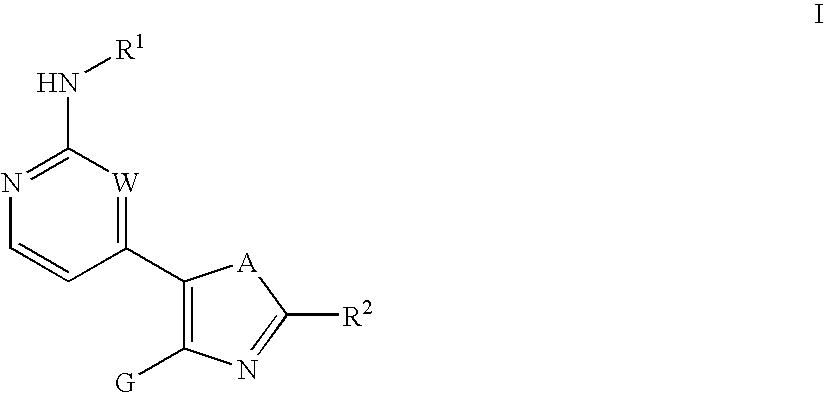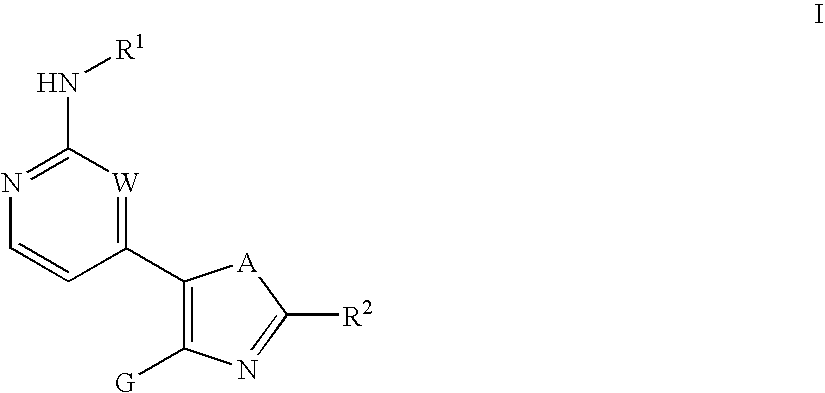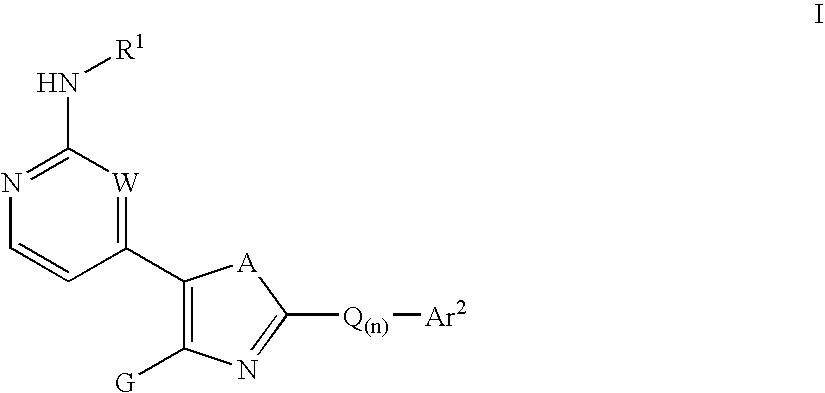Inhibitors of c-Jun N-terminal kinases (JNK) and other protein kinases
a technology of c-jun n-terminal kinases and other proteins, applied in the field of cjun n-terminal kinases (j), can solve the problems of poor ability of mice without the lck gene to develop thymocytes, cellular proliferation and other abnormalities, and achieve the effects of preventing thrombin-induced platelet aggregation, preventing cell death and hyperplasia, and treating or preventing reperfusion/isch
- Summary
- Abstract
- Description
- Claims
- Application Information
AI Technical Summary
Problems solved by technology
Method used
Image
Examples
example 1
[0229]
3-Chloro-4,4-dimethoxy-butan-2-one (1)
[0230]To a solution of 4-methoxy-but-3-en-2-one (9.0 g, 90.0 mmol) in 100 ml MeOH was added pyridine (14.2 g, 180 mmol). Gaseous Cl2 was introduced into the above mixture under vigorous stirring at room temperature. After 5 minutes, Cl2 source was removed and the reaction was cooled to room temperature. The resultant reaction mixture was concentrated to yellow oil under vacuo. and was then partitioned between CH2Cl2 and aqueous NaHCO3. The aqueous layer was extracted with CH2Cl2 (150 ml×3), and the combined organic layers were dried over Na2SO4. Removal of the solvent afforded a crude material in which desired product (1) was the major product. The resulting crude material was used without further purification. 1H NMR (CDCl3, ppm) δ: 4.45 (d, 1H), 4.12 (d, 1H), 3.25 (s, 3H), 3.22 (s, 3H) and 2.20 (s, 3H).
example 2
[0231]
1-(2-Phenyl-3-H-imidazol-4-yl)-ethanone (2′)
[0232]To a solution of 1 (2.2 g, 13.3 mmol) in 20 ml 1,4-dioxane was added benzamidine (3.24 g, 20.0 mmol) and sodium acetate (2.83 g, 33.3 mmol). The reaction was refluxed in an oil bath at 110° C. over 60 hours. After the reaction was cooled to room temperature, the salt was removed through a plug of celite and the filtrate was concentrated to a red oil. This oil was then taken up in ethyl acetate (50 ml) and extracted with 1N HCl (17 ml×3). The combined aqueous layers were basified with aqueous Na2CO3 and then were extracted with ethyl acetate (50 ml×3). The combined organic layers were dried over Na2SO4 and the solvent was removed. Purification by chromatography using CH2Cl2 / MeOH (95:5 / v:v) afforded 2′ (1.02 g) as the desired product in 41% yield. 1H NMR (acetone-d6, ppm) δ: 7.4-8.1 (m, 7H) and 2.42 (s, 3H).
example 3
[0233]
3-Dimethylamino-1-(2-phenyl-3H-imidazol-4-yl)-propenone (4′)
[0234]To a solution of 2′ (186 mg, 1.0 mmol) in 5 ml toluene was added dimethoxymethyldimethylamine (595 mg, 5.0 mmol). The reaction was heated in a sealed tube at 98° C. overnight. The reaction was cooled to room temperature and was then concentrated to an oil under vacuo. Purification of the crude oil by chromatography using 3% MeOH in CH2Cl2 afforded the desired product 4′ in 30% yield. 1H NMR (CDCl3, ppm) δ: 8.05 (d, 2H), 7.7 (d, 1H), 7.6 (s, 1H), 7.3 (m, 3H), 5.6 (d, 2H), 3.1 (bs, 3H) and 2.8 (bs, 3H).
PUM
| Property | Measurement | Unit |
|---|---|---|
| temperature | aaaaa | aaaaa |
| period of time | aaaaa | aaaaa |
| temperature | aaaaa | aaaaa |
Abstract
Description
Claims
Application Information
 Login to View More
Login to View More - R&D
- Intellectual Property
- Life Sciences
- Materials
- Tech Scout
- Unparalleled Data Quality
- Higher Quality Content
- 60% Fewer Hallucinations
Browse by: Latest US Patents, China's latest patents, Technical Efficacy Thesaurus, Application Domain, Technology Topic, Popular Technical Reports.
© 2025 PatSnap. All rights reserved.Legal|Privacy policy|Modern Slavery Act Transparency Statement|Sitemap|About US| Contact US: help@patsnap.com



